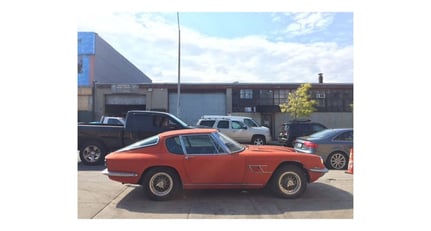1967 Maserati Mistral
4.0 - Maserati test and demo car-
Year of manufacture7/1967
-
Car typeCoupé
-
Chassis numberAM109 A1*1416*
-
Electric windowsYes
-
DriveLHD
-
ConditionRestoration Project
-
Exterior brand colourVolpe Argentata - Dark Brown
-
Interior colourBlack
-
Interior brand colourSenape - Tan
-
Interior typeLeather
-
Number of doors2
-
Number of seats2
-
Location

-
Exterior colourRed
-
GearboxManual
-
Drivetrain2wd
-
Fuel typePetrol
Description
Built in July 1967, this particular Mistral was draped in the elegant colourings of “Volpe Argentata” (dark brown) and “Pelle senape” (Tan pac 1775). This colour scheme evokes the sophistication and style synonymous with Maserati. Before its sale, the vehicle was utilized by Maserati for testing and demonstrations, a testament to its exemplary performance and reliability.
The Mistral, introduced at the Torino Salone in November 1963, was an immediate success. Its designer, Pietro Frua, had long aspired to be the lead designer for a major Maserati production model. With the Mistral, his dream was realized. The car was named after a wind, a tradition that would continue with many future Maseratis. The wind, after which the vehicle was named Le Mistral, sweeps through France’s Rhone river valley towards the Mediterranean.
With a shorter chassis than the Sebring and no design commonalities with the 3500GT or Sebring, the Mistral struck onlookers with its unique and simplistic design. The front of the car was notably innovative, with pure lines and the entire air intake located under the full-width front bumper. The rear featured an unusual hatchback configuration with a large glass panel and a slightly rearward leaning back end.
The production of the Mistral was an elaborate process involving multiple stages and subcontractors. The chassis, produced by Maserati, was sent to the Turinese firm Maggiora for body manufacturing and fitting. The bodies, made of steel or aluminium, were then sent to Officine Padane for pre-assembly, including interiors, electrical circuits, and the fitting of doors, bonnet, and hatch, before returning to Maserati for the final assembly of mechanical components.
The Mistral initially launched with a 3.5-litre engine, but most were produced with a 3.7-litre and later a 4-litre capacity. It featured Lucas fuel injection and a ZF five-speed transmission as standard, with options like air conditioning and a rare three-speed Borg-Warner automatic gearbox.
From 1963 to 1969, 844 Mistrals were built, with the 4.0-litre engine models being the most numerous. The Mistral marked the end of the inline 6-cylinder model evolution for Maserati. With a power output that evolved from 245 hp to 265 hp and a performance range of 235 kph to 255 kph, the Mistral was not just a car but a statement of luxury and performance.
The story of AM109 A1 *1416* is not just that of a car but of a legacy. Sold directly from the Maserati factory to Dr. Edgardo Zavoli in Rimini, Italy, this Mistral’s journey from a test and demonstration vehicle to a cherished possession illustrates Maserati’s enduring allure and prestige.
















